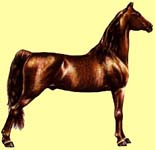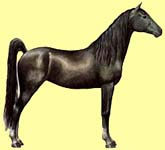|
|
American SaddlebredFormerly the Kentucky Saddler |
|
|
|
American SaddlebredFormerly the Kentucky Saddler |
|
 The American Saddlebred is a meso-dolichomorphic horse that was developed in the southern states of America during the late 18th and the 19th centuries. It became known as the Kentucky Saddlehorse because its origins are generally in and around Kentucky, and it is of national importance. Today the Saddlebred is the most famous and popular of the American gaited breeds. Developed for practical uses, the Saddler performed a variety of farm tasks under saddle and in harness. The Saddlebred has the ability to carry a human, with gear, all day on rough ground with no discomfort to the rider. Also an elegant breed, this horse was frequently used as a carriage horse. The Saddlebred is strong with good endurance; is docile, though energetic; and has an aptitude as a riding horse and for light draft. It is used primarily under saddle.
The American Saddlebred is a meso-dolichomorphic horse that was developed in the southern states of America during the late 18th and the 19th centuries. It became known as the Kentucky Saddlehorse because its origins are generally in and around Kentucky, and it is of national importance. Today the Saddlebred is the most famous and popular of the American gaited breeds. Developed for practical uses, the Saddler performed a variety of farm tasks under saddle and in harness. The Saddlebred has the ability to carry a human, with gear, all day on rough ground with no discomfort to the rider. Also an elegant breed, this horse was frequently used as a carriage horse. The Saddlebred is strong with good endurance; is docile, though energetic; and has an aptitude as a riding horse and for light draft. It is used primarily under saddle.
Developed by Kentucky pioneers as an "all-around asset," it was "comfortable and fast to ride the trails and plantations; stylish and eye-catching to pull fancy buggies; strong and tractable to pull a plough; and fast and courageous to race against other farmers' horses on special occasions" (Kidd, Jane International Encyclopedia of Horse Breeds). The stock used to meet the demands came from Thoroughbred, Morgan, and Trotter blood as well as the now extinct Narragansett Pacers. The Saddlebred was developed into a distinctive and impressive horse. It inherits its gaits from its two naturally gaited ancestors, the Canadian Pacer and the Narragansett Pacer.
It is believed by some that the English Hackney may have also been used to influence the eleganct carriage of the breed. The Thoroughbred contributed quality, spirit, and further brilliance of movement of the Saddlebred. From the Norfolk Roadster, it inherited trotting ability and outline. The Narragansett Pacer contributed to the special gaits of the Saddlebred and Spanish breeds transmitted hardiness, stamina, and added a spectacular quality to its gaits. The old Narragansett Pacer, now extinct, was workhorse of the Rhode Island plantations. The breed was refined and acquired its impressive eye-catching appearance, speed, and brilliance of movement through the introduction of Morgan and Thoroughbred blood. This horse was created as a dual-purpose riding and light draft breed. The Saddlebred inherits a specialized action is a legacy of the old, Spanish-based pacers and amblers while it's fire, speed and beauty of form derive from the Thoroughbred.
The most famous Thoroughbred used was Denmark (1839), whose son, Gaines Denmark (1851) is the officially recognized foundation sire. This resulted in a "horse with speed, action, style and stamina, that gained fame as the mounts of many well-known generals in the Civil War" (ibid). The American Saddle Horse Association was formed, in Louisville, Kentucky, in 1891. It was one of the earliest breed associations to exist in the United States. Once the register was started, careful selection of parents with adherence to a recognized type was encouraged.
The Saddlebred stands between 15 and 16 hands (1.52 - 1.62 m) at the withers, sometimes a little more. Its the coat is usually bay, black, chestnut, or grey, though roans, palominos, and pintos do occur. Most are either bay or chestnut. The hair is noticeably silky and fine. It has a small, finely drawn head with a straight or slightly convex profile and reflects the quality of the breed. Its small, alert ears are neat, sharp and pointed. It has a small muzzle and flared nostrils are wide and open. It has large, bold eyes which are set well apart. The Saddlebred's long, arched neck is without fleshiness in the jowl, and set high into its prominent withers to give a high, elevated head carriage, which is a significant feature of the breed. Its clean and sharp withers are much higher than usual harness horses. It has a wide, deep chest and a particularly good, long, sloping, and well-muscled shoulder. Its scapula blades are fairly close together at the withers to give a free action to its movement.
The Saddlebred's outline is reminiscent of the English Hackney, yet conforms to the breed's riding requirement. It has particularly well sprung ribs and its outline, even when stood out in the show fashion is elegant. The Saddlebred has a strong, straight back that may be fairly long or notably short, and its quarters have a flat, level croup with a well set-on tail. It has well-muscled quarters which add brilliance to the action. The tail is carried erect due to a nicking process of the muscles or nerve called a myotomy or neurotome. Its long and slender legs have good bone structure and joints, yet are light and elegant, and the tendons are well-defined. The pasterns are long and sloping, which emphasize the comfortable, springy, and exceptionally smooth walking action of the breed. The hoof is small and solid, open at the heel. The Saddlebred's natural stance is not correct and is thrust forward in front and straight-hocked in the back, again to emphasize the comfortable walking gait. The hooves are grown long, especially in front, and heavy shoes are used which encourage the horse to lift its feet much higher than other breeds.
This brilliant show horse is still shown in harness and as a pleasure or trail horse when the hooves are trimmed naturally. The Saddlebred is also used to work cattle, jump and compete in dressage tests. The American Saddlebred Association describes it as 'America's most misunderstood breed' due to the artificial way in which it is produced and the show ring image. It is beautiful at liberty, and moves with great, natural elegance and freedom. High carriage of its head and tail is typical for the breed, and adds to the stately presence of this uniquely attractive horse. Although it is used for many purposes, it is agile, fast, intelligent, responsive, strong and balanced. The Saddlebred is popular for pleasure riding, driving, hunting, jumping, and as a parade horse, but it is still best known as a show horse. There are three divisions in which the Saddlebred is shown - Three-Gaited, Five-Gaited, and Fine Harness Horse.

The three divisions are sub-divided. Each may have performance, pleasure and equitation classes. In performance,emphasis is on activity and motion. In pleasure, emphasis is on manners and the provision of a pleasant ride, (here even the Three-Gaited have a full mane). In equitation classes, riders are judged for their skill in presenting their mounts.
For more information visit:

|
© 1997-2007
NW Breyer Horse Club & Refiner of Gold Creations Equinealities in place since 1997, Section in place 2001, Updated 3/13/2007 |



|
| ||

|
|||||